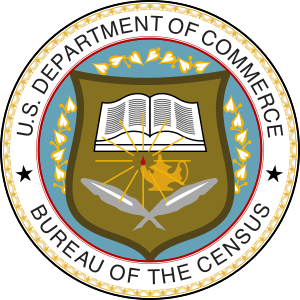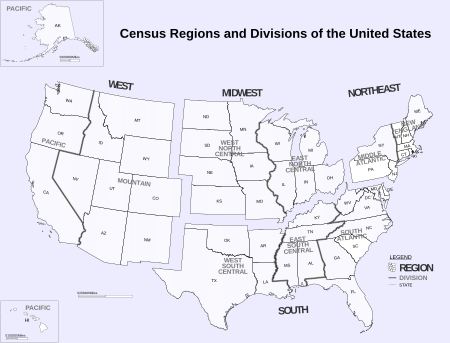United States Census Bureau facts for kids
 |
|
 |
|
| Agency overview | |
|---|---|
| Formed | July 1, 1902 |
| Preceding agency |
|
| Headquarters | 4600 Silver Hill Road, Suitland, Maryland, U.S. (Washington, D.C. mailing address) |
| Agency executive |
|
| Parent agency | U.S. Department of Commerce |
The United States Census Bureau (USCB), officially the Bureau of the Census, is a principal agency of the U.S. Federal Statistical System, responsible for producing data about the American people and economy. The Census Bureau is part of the U.S. Department of Commerce and its director is appointed by the President of the United States.
The Census Bureau's primary mission is conducting the U.S. census every ten years, which allocates the seats of the U.S. House of Representatives to the states based on their population. The bureau's various censuses and surveys help allocate over $675 billion in federal funds every year and it assists states, local communities, and businesses make informed decisions. The information provided by the census informs decisions on where to build and maintain schools, hospitals, transportation infrastructure, and police and fire departments.
In addition to the decennial census, the Census Bureau continually conducts over 130 surveys and programs a year, including the American Community Survey, the U.S. Economic Census, and the Current Population Survey. Furthermore, economic and foreign trade indicators released by the federal government typically contain data produced by the Census Bureau.
Contents
Legal mandate

Article One of the United States Constitution (section II) directs the population be enumerated at least once every ten years and the resulting counts used to set the number of members from each state in the House of Representatives and, by extension, in the Electoral College. The Census Bureau now conducts a full population count every ten years in years ending with a zero and uses the term "decennial" to describe the operation. Between censuses, the Census Bureau makes population estimates and projections.
In addition, census data directly affects how more than $400 billion per year in federal and state funding is allocated to communities for neighborhood improvements, public health, education, transportation and more. The Census Bureau is mandated with fulfilling these obligations: the collecting of statistics about the nation, its people, and economy. The Census Bureau's legal authority is codified in Title 13 of the United States Code.
The Census Bureau also conducts surveys on behalf of various federal government and local government agencies on topics such as employment, crime, health, consumer expenditures, and housing. Within the bureau, these are known as "demographic surveys" and are conducted perpetually between and during decennial (10-year) population counts. The Census Bureau also conducts economic surveys of manufacturing, retail, service, and other establishments and of domestic governments.
Between 1790 and 1840, the census was taken by marshals of the judicial districts. The Census Act of 1840 established a central office which became known as the Census Office. Several acts followed that revised and authorized new censuses, typically at the 10-year intervals. In 1902, the temporary Census Office was moved under the Department of Interior, and in 1903 it was renamed the Census Bureau under the new Department of Commerce and Labor. The department was intended to consolidate overlapping statistical agencies, but Census Bureau officials were hindered by their subordinate role in the department.
An act in 1920 changed the date and authorized manufacturing censuses every two years and agriculture censuses every 10 years. In 1929, a bill was passed mandating the House of Representatives be reapportioned based on the results of the 1930 census. In 1954, various acts were codified into Title 13 of the U.S. Code.
By law, the Census Bureau must count everyone and submit state population totals to the U.S. president by December 31 of any year ending in a zero. States within the Union receive the results in the spring of the following year.
Data collection
Census regions and divisions
The United States Census Bureau defines four statistical regions, with nine divisions. The Census Bureau regions are "widely used...for data collection and analysis". The Census Bureau definition is pervasive. The territories are not included, but the District of Columbia is.
Regional divisions used by the United States Census Bureau:
- Region 1: Northeast
- Division 1: New England (Connecticut, Maine, Massachusetts, New Hampshire, Rhode Island, and Vermont)
- Division 2: Mid-Atlantic (New Jersey, New York, and Pennsylvania)
- Region 2: Midwest (Prior to June 1984, the Midwest Region was designated as the North Central Region.)
- Division 3: East North Central (Illinois, Indiana, Michigan, Ohio, and Wisconsin)
- Division 4: West North Central (Iowa, Kansas, Minnesota, Missouri, Nebraska, North Dakota, and South Dakota)
- Region 3: South
- Division 5: South Atlantic (Delaware, the District of Columbia, Florida, Georgia (US state), Maryland, North Carolina, South Carolina, Virginia, and West Virginia)
- Division 6: East South Central (Alabama,Kentucky, Mississippi, and Tennessee)
- Division 7: West South Central (Arkansas, Louisiana, Oklahoma, and Texas)
- Region 4: West
- Division 8: Mountain (Arizona, Colorado, Idaho, Montana, Nevada, New Mexico, Utah, and Wyoming)
- Division 9: Pacific (Alaska, California, Hawaii, Oregon, and Washington)
History
The current system was introduced for the 1910 census, but other ways of grouping states were used historically by the Census Bureau. The first of these was introduced after the 1850 census by statistician and later census superintendent J. D. B. De Bow. He published a compendium where the states and territories were grouped into five "great division", namely the Middle, New England, the Northwestern, the Southern, and the Southwestern great divisions. Unsatisfied with this system, De Bow devised another one four years later, with states and territories grouped into an Eastern, Interior, and Western "great section", each divided into a northern and southern half called "divisions".
In the following decades, several other systems were used, until the current one was introduced in 1910. This system has seen only minor changes: New Mexico and Arizona were both added to the Mountain division upon statehood in 1912, the North region was divided into a Northeast and a North Central region in 1940, Alaska and Hawaii were both added to the Pacific division upon statehood in 1959, and the North Central region was renamed the Midwest in 1984.
Uses of census data
Many federal, state, local and tribal governments use census data to:
- Decide the location of new housing and public facilities,
- Examine the demographic characteristics of communities, states, and the US,
- Plan transportation systems and roadways,
- Determine quotas and creation of police and fire precincts, and
- Create localized areas for elections, schools, utilities, etc.
- Gathers population information every 10 years
Census data is not used to determine or define race genetically, biologically or anthropologically.
Data stewardship
The United States Census Bureau is committed to confidentiality and guarantees non-disclosure of any addresses or personal information related to individuals or establishments. Title 13 of the U.S. Code establishes penalties for the disclosure of this information. All census employees must sign an affidavit of non-disclosure prior to employment.
The bureau cannot share responses, addresses or personal information with anyone, including the United States or foreign governments, or law enforcement agencies such as the IRS or the FBI or Interpol. "Providing quality data, for public good—while respecting individual privacy and, at the same time, protecting confidentiality—is the Census Bureau's core responsibility"; "Keeping the public's trust is critical to the Census's ability to carry out the mission as the leading source of quality data about the Nation's people and economy." Only after 72 years does the information collected become available to other agencies or the general public. Seventy-two years was picked because usually by 72 years since the census is taken, most participants would be deceased.
Despite these guarantees of confidentiality, the Census Bureau has some history of disclosures to other government agencies. In 1918, the Census Bureau released individual information regarding several hundred young men to the Justice Department and Selective Service system for the purpose of prosecutions for draft evasion. During World War II, the United States Census Bureau assisted the government's Japanese American internment efforts by providing confidential neighborhood information on Japanese-Americans. The bureau's role was denied for decades but was finally proven in 2007.
United States census data are valuable for the country's political parties; Democrats and Republicans are highly interested in knowing the accurate number of persons in their respective districts. These insights are often linked to financial and economic strategies that are central to federal, state and city investments for locations of particular populations. Such apportionments are designed to distribute political power across neutral spatial allocations; however, "because so much is at stake, the census also runs the risk of being politicized."
Such political tensions highlight the complexity of identity and classification; some argue that unclear results from the population data "is due to distortions brought about by political pressures." One frequently used example includes ambiguous ethnic counts, which often involves underenumeration and/or undercounting of minority populations. Ideas about race, ethnicity and identity have also evolved in the United States, and such changes warrant examination of how these shifts have impacted the accuracy of census data over time.
The United States Census Bureau began pursuing technological innovations to improve the precision of its census data collection in the 1980s. Robert W. Marx, the Chief of the Geography Division of the USCB teamed up with the U.S. Geological Survey and oversaw the creation of the Topologically Integrated Geographic Encoding and Referencing (TIGER) database system. Census officials were able to evaluate the more sophisticated and detailed results that the TIGER system produced; furthermore, TIGER data is also available to the public. And while the TIGER system does not directly amass demographic data, as a geographic information system (GIS), it can be used to merge demographics to conduct more accurate geospatial and mapping analysis.
In July 2019 the Census Bureau deprecated American FactFinder, which was decommissioned in March 2020 after 20 years of being the agency's primary tool for data dissemination. The new platform is data.census.gov.
Images for kids
See also
 In Spanish: Oficina del Censo de los Estados Unidos para niños
In Spanish: Oficina del Censo de los Estados Unidos para niños



